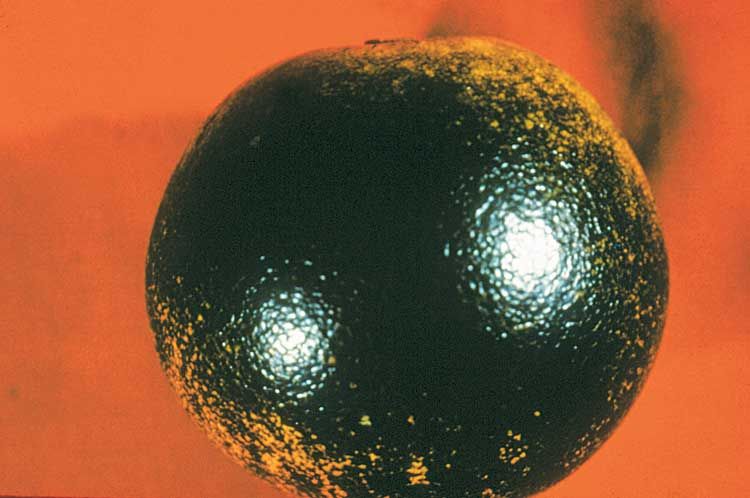Citrus Rust Mite, Phyllocoptruta oleivora (Ashmead)
Citrus rust mite (CRM) damage epidermal cells of plant leaves, fruit, and green twigs of all citrus varieties using piercing-sucking mouthparts. The adult body is elongated and wedge-shaped, approximately three times longer than wide. Magnification is required to see CRM as the adult is extremely small, about 0.15 mm long with the immature stages being slightly smaller. Color ranges from light yellow to straw (Figure 1). CRM can be found any time during the year with peak populations usually occurring during June and July. CRM prefer outer canopy fruit exposed to sunlight but avoids the most sun-exposed portion of the fruit (Figure 2). Populations of CRM can develop quickly under ideal conditions with a female laying up to 20 to 30 eggs over a 20-day period. Eggs are spherical, clear, and found along leaf midribs or clustered in fruit depressions.


Citrus Rust Mite Damage to Fruit
Extensive citrus rust mite (CRM) feeding on the fruit surface will result in surface blemishes which can lower external grade of fresh fruit, reduce fruit size, and increase fruit drop. Damage and fruit drop is dependent on population levels and the duration of feeding. When a fruit is injured in summer or fall, the injured surface is smooth and dark brown in color, commonly referred to as "bronzing" (Figure 3). CRM feeding on fruit early in the spring produces a peel which is somewhat rough in texture but lighter in color than damage caused by feeding in the summer and referred to as "sharkskin" (Figure 4).


Pink Citrus Rust Mite, Aculops pelekassi (Keifer)
The Pink Citrus Rust Mite is pink to reddish in color, elongated, with a distinctive rounded body or concave back. Eggs are flattened, opaque, and can be found scattered along the leaf or fruit surfaces (Figure 5). This mite is often found at leaf margins of young leaves.

Pink Citrus Rust Mite Damage to Fruit and Leaves
Pink citrus rust mite (PCRM) will begin feeding on very small fruit during April or May with potentially serious damage occurring on fruit less than 1 inch (3 cm) in diameter especially during dry spring conditions or following a dry winter (Figure 6). On leaves, PCRM is capable of causing distortion when large populations feed on new citrus growth, a form of damage not caused by CRM. Monitor groves especially in early April-May for PCRM.

Citrus Red Mite, Panonychus citri (McGregor)
The citrus red mite (RM) is deep red to reddish purple in color (Figure 7). The female is oval and about 0.5 mm long and has white setae arising from the dorsal body surface. The adult male has long legs, a tapering abdomen and is smaller than the female. The round, red eggs have a vertical stalk projecting upward with webbing often between the stalk and leaf surface.

Citrus Red Mite Leaf Damage
Citrus red mites feed on leaves, green twigs, and fruit using piercing-sucking mouthparts. Visible injury is characterized by light colored, scratched (etched) areas which give the upper leaf surface a silvery appearance (Figure 8). This stippling results from destruction of cells. Mite feeding and environmental stress can lead to mesophyll collapse and leaf abscission. Firing (sudden desiccation and leaf abscission from healthy stems) has been reported when extensive feeding occurs on leaf surfaces in localized areas of the canopy. Fruit and twig damage are rarely seen.

Texas Citrus Mite Eutetranychus banksi (McGregor)
Adult Texas citrus mites (TCM) are about 0.5 mm long. Males are more slender than females. TCM are tan to brownish green with dark green to black spots on the upper side of body (Figure 9). Females are broadly oval and somewhat flattened. Adult and nymphal mites have 8 legs and the larval stage has only 6 legs. The egg is flat and disc-shaped with a pronounced rim. Color varies from yellow to green prior to hatching.
The mite prefers the upper leaf surface with eggs being deposited primarily along the midrib and lateral veins. Developing TCM infestations tend to move from the inner to outer leaf areas. Infestations can occur year round with highest numbers in spring when humidity conditions are low. Injury is identical to damage caused by the citrus red mite.

Six-Spotted Mite, Eotetranychus sexmaculatu (Riley)
The adult female six-spotted mite (SSM) is pale yellow, oval, 0.35 mm long, with 1 to 3 pairs of dark spots on the upper surface of the body, and slightly smaller than either the citrus red mite or Texas citrus mite (Figure 10). Long setae are visible on the dorsal surface of the mite. The males have a more tapered body with longer legs and are smaller than the females. Adults and nymphs have 8 legs while the larval stage has only 6 legs. SSM are found mostly along the petiole, midrib, or lateral veins on the lower leaf surface usually in dense colonies covered with webbing. Eggs are round and light yellow in color, with a short stalk or mast extending vertically.

Six-Spotted Mite Damage to Leaf Surface
Highest populations are commonly found in early spring, as well as throughout the year. SSM prefer the under side of the leaf, producing extensive webbing. Usually damage is first observed on lower canopy leaves between March-May. Feeding causes a discoloration of the leaf surface in response to cell damage which collapses inward, causing the leaf to bulge upward. These areas are visible on the upper side of heavily infested leaves. Yellow, indented areas develop on the lower leaf surface as colonies feed and develop (Figure 11). Extensive feeding can induce defoliation.
